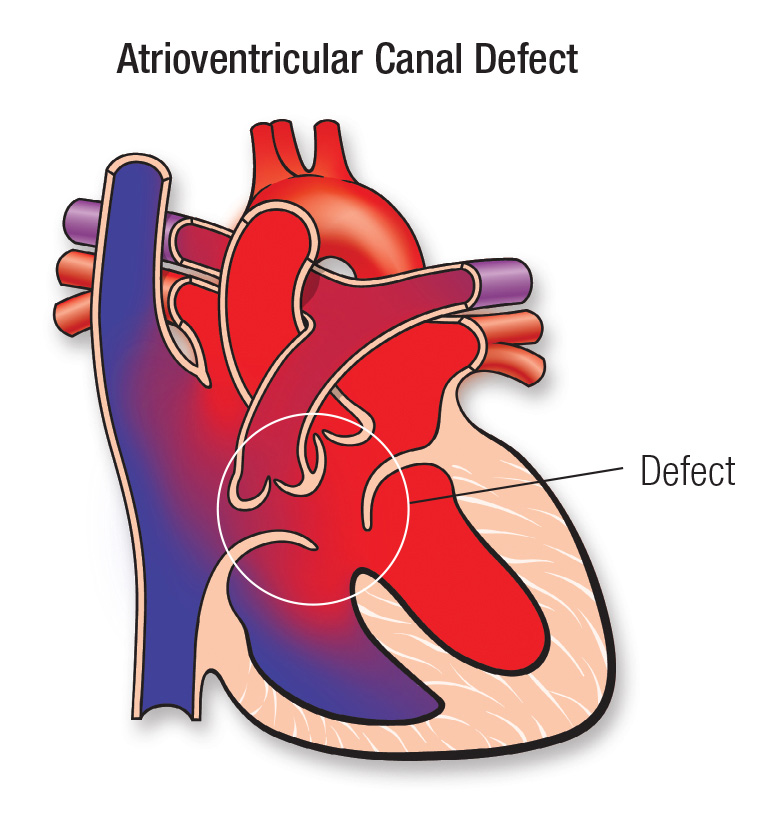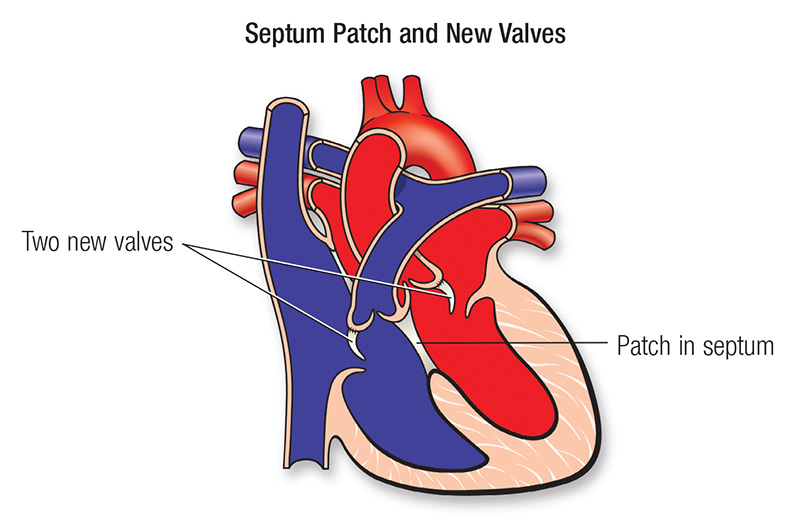Complete Atrioventricular Canal defect (CAVC)
Defecto del canal atrioventricular completo

What is it?
Many terms are used to describe this complex defect. They include atrioventricular (AV) canal, complete AV canal, complete common AV canal, atrioventricular septal defect and endocardial cushion defect.
A large hole in the center of the heart affecting all four chambers where they would normally be divided. When a heart is properly divided, the oxygen-rich blood from the lungs does not mix with the oxygen-poor blood from the body. A CAVC allows blood to mix and the chambers and valves to not properly route the blood to each station of circulation.
Atrioventricular (AV) canal defect is a large hole in the center of the heart. It's located where the wall (septum) between the upper chambers (atria) joins the wall between the lower chambers (ventricles). This septal defect involves both upper and lower chambers. The tricuspid and mitral valves that normally separate the heart's upper and lower chambers aren't formed as individual valves. Instead a single large valve forms that crosses the defect in the wall between the two sides of the heart.
More information for parents of children with CAVC
What causes it?
In most children, the cause isn't known. It's a very common type of heart defect in children with a chromosome problem, Trisomy 21 (Down syndrome). Some children can have other heart defects along with AV canal.
How does it affect the heart?
Normally, the left side of the heart only pumps blood to the body, and the heart's right side only pumps blood to the lungs. In a child with AV canal defect, blood can travel across the holes from the left heart chambers to the right heart chambers and out into the lung arteries. The extra blood being pumped into the lung arteries makes the heart and lungs work harder and the lungs can become congested.
How does the AV canal defect affect my child?
A child with AV canal defect may breathe faster and harder than normal. Infants may have trouble feeding and growing at a normal rate. Symptoms may not occur until several weeks after birth. High pressure may occur in the blood vessels in the lungs because more blood than normal is being pumped there. Over time this causes permanent damage to the lung blood vessels.
In some infants, the common valve between the upper and lower chambers doesn't close properly. This lets blood leak backward from the heart's lower chambers to the upper ones. This leak, called regurgitation or insufficiency, can make the heart work harder, too.

What can be done about the defect?
An AV canal can be fixed. Open-heart surgery is needed to repair the defect. Unlike some other types of septal defects, the AV canal defect can't close on its own. Medicines may be used temporarily to help with symptoms, but they don't cure the defect or prevent permanent damage to the lung arteries.
In an infant with severe symptoms or high blood pressure in the lungs, surgery must usually be done in infancy. During the operation, the surgeon closes the large hole with one or two patches. Later the patch will become a permanent part of the heart as the heart's lining grows over it. The surgeon also divides the single valve between the heart's upper and lower chambers and makes two separate valves. These will be made as close to normal valves as possible.
If an infant is very ill, or has a defect that may be too complex to repair in infancy, a temporary operation to relieve symptoms and high pressure in the lungs may be needed. This procedure (pulmonary artery banding) narrows the pulmonary artery to reduce the blood flow to the lungs. When the child is older, an operation is done to remove the band and fix the AV canal defect with open-heart surgery.
What activities can my child do?
If the AV canal defect has been closed with surgery, your child may not need any special precautions regarding physical activities and may be able to participate in normal activities without increased risk. Being physically active is healthy for the cardiovascular system, but some children may need to limit their activity. Discuss this with your child's pediatric cardiologist.
What will my child need in the future?
After surgery your child must be examined regularly by a pediatric cardiologist. More medical or surgical treatment is sometimes needed.
Surgical repair of an AV canal usually restores the blood circulation to normal. However, the reconstructed valve may not work normally. The valve structures can leak or narrow. But, for many children, the long-term outlook is good, and usually no medicines or additional surgery are needed.
What about preventing endocarditis?
Children with AV canal defect may risk endocarditis both before and after repair. Ask about your child's risk of endocarditis and about your child's need to take antibiotics before certain dental procedures. See the section on Endocarditis for more information.
Congenital Heart Defect ID sheet
More information for adults with CAVC
Some patients with AV canal defects have a small or no opening between the bottom chambers of the heart. They can present in adulthood with findings similar to patients with atrial septal defects; this can be referred to as an "ostium primum" atrial septal defect. Even less commonly, only the hole between the lower chambers is present.
What causes it?
In most cases, the cause isn't known. It's a very common type of heart defect in children with a chromosome problem, Trisomy 21 (Down syndrome). Some patients can have other heart defects along with AV canal.
How does it affect the heart?
Normally, the left side of the heart only pumps blood to the body, and the heart's right side only pumps blood to the lungs. In a child with AV canal defect, blood can travel across the holes from the left heart chambers to the right heart chambers and out into the lung arteries. The extra blood being pumped into the lung arteries makes the heart and lungs work harder, and the lungs can become congested. Sometimes there's leakiness (regurgitation) of the abnormal single valve. This may add to the heart failure symptoms.
How does the AV canal defect affect patients?
High pressure may occur in the blood vessels in the lungs that can lead to permanent damage with pulmonary hypertension that persists into adulthood.
Many adults who have not had previous repair have pulmonary hypertension (see Eisenmenger's syndrome). This complication is more common than in patients with an ASD or a VSD. Even in adults without Eisenmenger's syndrome, symptoms including shortness of breath, intolerance to exercise and palpitations are common. On physical examinations, murmurs due to the blood flow across the defects and due to the valve leak are common.
If my AV canal defect was closed in childhood, what was done and what can I expect?

The surgery to fix these defects involves patching the ASD and the VSD and repairing the heart valve. To repair the valve, the surgeon divides the single valve between the heart's upper and lower chambers and makes two separate valves. These are made as close to normal valves as possible. It's possible that a temporary operation to relieve symptoms and high pressure in the lungs may have been performed before the definitive operation. This procedure (pulmonary artery banding) narrows the pulmonary artery to reduce the blood flow to the lungs. When the child was older, an operation was done to remove the band and fix the AV canal defect with open-heart surgery. Unlike some other types of septal defects, the AV canal defect never closes on its own.
Surgical repair of an AV canal usually restores blood circulation to normal. For many patients, the long-term outlook is good, and no medicines or additional surgery are needed. Because this is a more complicated congenital heart defect, late problems in adults are more common than after an ASD or VSD is closed. As the child grows, the repair may partially break down leading to patch leaks, valve leakage and narrowing of the blood flow channel to the body. These problems may increase the workload of the heart and cause symptoms.
What if the AV canal defect is still present? Should it be repaired in adulthood?
The decision to repair an AV canal defect in adulthood is complicated. It depends on the pressures in the lung and the heart's pumping function. However, when the pressures aren't too high and the pump function is good, these defects can be repaired and adult patients are likely to improve. A heart catheterization is almost always required to know whether the defect should be closed. These defects can't be closed or repaired in the catheterization laboratory, however, because of their location and the need to fix the heart valves.
Problems You May Have
Problems in patients with repaired AV canals depend on whether there are patch leaks and whether there's a lot of valve regurgitation. Shortness of breath, inability to exercise and swelling in the legs are all signs of heart failure. Abnormal heart rhythms may cause palpitations (skipped or rapid heartbeats) and, rarely, fainting. Some patients may need a pacemaker after the repair if the electrical system has been damaged.
Patients with unrepaired AV canal are often blue (see Eisenmenger's syndrome). Because of valve leaks on the heart's left side, they're more likely to have heart failure than other patients with Eisenmenger's syndrome, due to ASDs and VSDs.
Ongoing Care
What will I need in the future?
An adult with a repaired or unrepaired AV canal defect must be examined regularly by a cardiologist with experience in adult congenital heart disease. The frequency of the visits depends on the extent of problems with the repair, the presence of abnormal heart rhythms and pulmonary hypertension. In general, you should visit the cardiologist at least once a year. You should also consult a cardiologist with expertise in care of adult congenital heart disease if you're undergoing any type of non-heart surgery or invasive procedure or thinking about heart surgery.
Medical
Heart failure medications may be needed, especially in patients with valve regurgitation, to help their heart pump better and/or lower blood pressure. Patients with pulmonary hypertension may also require medications. Your cardiologist can monitor you with noninvasive tests if needed. These include electrocardiograms, Holter monitors, exercise stress tests and echocardiograms. When further surgery is contemplated, a heart catheterization is almost always needed.
What activities can I do?
If the AV canal defect has been closed with surgery, you may not need any special precautions and may be able to participate in normal activities without increased risk. However, patients with heart failure and pulmonary hypertension may need some restrictions.
Endocarditis Prevention
Patients with AV canal defects may risk an infection of the heart's inside lining or valves (endocarditis) before and after surgery. Lifelong endocarditis prophylaxis is recommended. See the section on endocarditis for more information.
Pregnancy
If after surgery you have no significant residual (leftover) problems, the risk from pregnancy is low. If there are problems like a leaking valve or irregular heart rhythms, you may be at increased risk for complications of pregnancy. If you have heart failure or pulmonary hypertension, pregnancy isn't recommended. Women with unrepaired AV canal defects or who have leftover problems should talk to their cardiologist before deciding to get pregnant. See the sections on Pregnancy and on Genetic Counseling for more information. Pregnant women with repaired AV canal defects who are free of significant problems may not require high risk obstetrical care. In contrast those unrepaired AV canal defects, significant valve leaks or pulmonary hypertension.
Will you need more surgery?
The function of the repaired valves is a long-term concern. Some patients will need their valve replaced with a mechanical one when they get older. It's rare that the valve can be further repaired. Other patients may need more surgery to close patch leaks.




